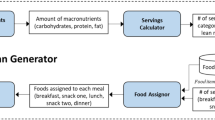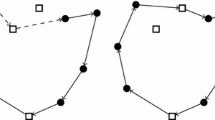Abstract
Home-delivered meals provision, also known as meals-on-wheels, is a volunteer-staffed activity for which little strategic planning is performed. We develop a Memetic Algorithm to solve the Home Delivered Meals Location-Routing Problem. This planning model addresses facility location, allocation of demand to facilities, and design of delivery routes, while balancing efficiency and effectiveness considerations. The case study presented on a large data set shows how trade-off curves, which are very useful for decision making, can be obtained by the method developed.





Similar content being viewed by others
References
Albareda-Sambola M, Diaz J and Fernández E (2005). A compact model and tight bounds for a combined location-routing problem. Computers and Operations Research 32 (3): 407–428.
Barreto S, Ferreira C, Paixao J and Santos B (2007). Using clustering analysis in a capacitated location-routing problem. European Journal of Operational Research 179 (3): 968–977.
Bartholdi J, Platzman L, Collins R and Warden W (1983). A minimal technology routing system for meals on wheels. Interfaces 13 (3): 1–8.
Berger R (1997). Location-routing models for distribution system design. Unpublished Dissertation, Northwestern University, Department of Industrial Engineering and Management Sciences, Evanston, IL, USA.
Bookbinder J and Reece K (1988). Vehicle routing considerations in distribution system design. European Journal of Operational Research 37 (2): 204–213.
Bruns A and Klose A (1995). An iterative heuristic for location-routing problems based on clustering. In: Proceedings of the Second International Workshop on Distribution Logistics, The Netherlands, pp 1–6.
Bruns A and Klose A (1997). A ‘locate first—route second’ heuristic for a combined location-routing problem. In: Zimmermann U, Derings U, Gaul W, Möhring RH and Schuster KP (eds). Operations Research Proceedings 1996. Springer; Berlin Heidelberg: New York, pp 49–54.
Caballero R, Gonzalez M, Guerrero F, Molina J and Paralera C (2007). Solving a multiobjective location routing problem with a metaheuristic based on tabu search. Application to a real case in Andalusia. European Journal of Operational Research 177 (3): 1751–1763.
Chan Y, Carter W and Burnes M (2001). A multiple-depot, multiple-vehicle, location-routing problem with stochastically processed demands. Computers and Operations Research 28 (8): 803–826.
Coello C (1999). A comprehensive survey of evolutionary-based multiobjective optimization techniques. Knowledge and Information systems 1 (3): 129–156.
Coello C and Romero C (2002). Evolutionary algorithms and multiple objective optimization. In: Ehrgott M and Gandibleux X (eds). Multiple Criteria Optimization: State of the Art Annotated Bibliographic Surveys. Kluwer Academic Publishers: New York.
Coello Coello C and Lamont G (2005). An introduction to multi-objective evolutionary algorithms and their applications. In: Coello Coello CA and Lamont GB (eds). Applications of Multi-Objective Evolutionary Algorithms. World Scientific Publishing: Singapore, pp 1–28.
Cornuejols G, Fisher M and Nemhauser G (1977). Location of bank accounts to optimize float: An analytic study of exact and approximate algorithms. Management Science 23 (8): 789–810.
Deb K (2001). Multi-Objective Optimization Using Evolutionary Algorithms. Wiley: New York.
Deb K, Pratap A, Agarwal S and Meyarivan T (2002). A fast and elitist multiobjective genetic algorithm: NSGA-II. IEEE Transactions on Evolutionary Computation 6 (2): 182–197.
Dunn K (2008). Euclidian traveling salesman problem solver. http://fly.hiwaay.net:8000/~kdunn/problems/tsp.shtml.
Gorr W, Johnson M and Roehrig S (2001). Spatial decision support system for home-delivered services. Journal of Geographic Systems 3 (2): 181–197.
Gunes C, van Hoeve W and Tayur S (2010). Vehicle routing for food rescue programs: A comparison of different approaches. Integration of AI and OR Techniques in Constraint Programming for Combinatorial Optimization Problems 6140:176–180.
Hansen P, Hegedahl B, Hjortkjaer S and Obel B (1994). A heuristic solution to the warehouse location-routing problem. European Journal of Operational Research 76 (1): 111–127.
Johnson M, Gorr W and Roehrig S (2002). Location/allocation/routing for home-delivered meals provision: Models & solution approaches. International Journal of Industrial Engineering 9 (1): 45–56.
Jones D, Mirrazavi S and Tamiz M (2002). Multi-objective meta-heuristics: An overview of the current state-of-the-art. European Journal of Operational Research 137 (1): 1–9.
Karp RM (1972). Reducibility among combinatorial problems. In: Miller RE and Thatcher JW (eds). Complexity of Computer Computations: Proceeding of a Symposium on the Complexity of Computer Computations, The IBM Research Symposia Series, Plenum Press: New York, NY, pp. 85–103.
Knowles J and Corne D (1999). The Pareto archived evolution strategy: A new baseline algorithm for Pareto multiobjective optimisation. In: Evolutionary Computation, 1999 CEC 99. Proceedings of the 1999 Congress on. Vol. 1, pp 98–105.
Knowles J and Corne D (2000). Approximating the nondominated front using the Pareto Archived Evolution Strategy. Evolutionary Computation 8 (2): 149–172.
Laporte G and Dejax P (1989). Dynamic location-routeing problems. Journal of the Operational Research Society 40 (5): 471–482.
Laporte G and Nobert Y (1981). Exact algorithm for minimizing routing and operating costs in depot location. European Journal of Operational Research 6 (2): 224–226.
Laporte G, Nobert Y and Pelletier P (1983). Hamiltonian location problems. European Journal of Operational Research 12 (1): 82–89.
Laporte G, Nobert Y and Arpin D (1986). An exact algorithm for solving a capacitated location-routing problem. Annals of Operations Research 6 (9): 291–310.
Laporte G, Nobert Y and Taillefer S (1988). Solving a family of multi-depot vehicle routing and location-routing problems. Transportation Science 22 (3): 161–172.
Laporte G, Louveaux F and Mercure H (1989). Models and exact solutions for a class of stochastic location-routing problems. European Journal of Operational Research 39 (1): 71–78.
Lenstra J and Kan AR (1981). Complexity of vehicle routing and scheduling problems. Networks 11 (2): 221–227.
Lin C and Kwok R (2006). Multi-objective metaheuristics for a location-routing problem with multiple use of vehicles on real data and simulated data. European Journal of Operational Research 175 (3): 1833–1849.
Lin C, Chow C and Chen A (2002). A location-routing-loading problem for bill delivery services. Computers & Industrial Engineering 43 (1–2): 5–25.
Lin S (1965). Computer solutions of the traveling salesman. Bell System Technical Journal 44 (10): 2245–2269.
Lopes R, Barreto S, Ferreira C and Santos B (2008). A decision-support tool for a capacitated location-routing problem. Decision Support Systems 46 (1): 366–375.
Madsen O (1983). Methods for solving combined two level location-routing problems of realistic dimensions. European Journal of Operational Research 12 (3): 295–301.
Medaglia A, Villegas J and Rodrguez-Coca D (2009). Hybrid biobjective evolutionary algorithms for the design of a hospital waste management network. Journal of Heuristics 15 (2): 153–176.
Michalewicz Z (1996). Genetic Algorithms+Data Structures=Evolution Programs. Springer: New York.
Nagy G and Salhi S (1996). Nested heuristic methods for the location-routeing problem. Journal of the Operational Research Society 47 (9): 1166–1174.
Nagy G and Salhi S (2007). Location-routing: Issues, models and methods. European Journal of Operational Research 177 (2): 649–672.
Or I and Pierskalla W (1979). A transportation location-allocation model for regional blood banking. IIE Transactions 11 (2): 86–95.
Pariazar M, Sir MY and Root S (2012). Robust supply chain design considering correlated failures and inspection. University of Missouri-Columbia: Columbia, MO, Working Paper.
Perl J and Daskin M (1985). A warehouse location-routing problem. Transportation Research 19 (5): 381–396.
Prins C, Prodhon C and Calvo R (2006a). A memetic algorithm with population management (MA∣PM) for the capacitated location-routing problem. In: Jens G and Günther R (eds). Evolutionary Computation in Combinatorial Optimization: 6th European Conference, EvoCOP 2006, Budapest, Hungary, April 10–12, 2006: Proceedings. Springer: New York.
Prins C, Prodhon C and Calvo R (2006b). Solving the capacitated location-routing problem by a GRASP complemented by a learning process and a path relinking. 4OR: A Quarterly Journal of Operations Research 4 (3): 47–64.
Prins C, Prodhon C, Ruiz A, Soriano P and Wolfler Calvo R (2007). Solving the capacitated location-routing problem by a cooperative Lagrangean relaxation-granular tabu search heuristic. Transportation Science 41 (4): 470.
Renaud J, Laporte G and Boctor F (1996). A tabu search heuristic for the multi-depot vehicle routing problem. Computers and Operations Research 23 (3): 229–235.
Solak S, Scherrer C and Ghoniem A (2012). The stop-and-drop problem in nonprofit food distribution networks. Annals of Operations Research: doi: 10.1007/s10479-012-1068-7.
Tuzun D and Burke L (1999). A two-phase tabu search approach to the location routing problem. European Journal of Operational Research 116 (1): 87–99.
Wong D and Meyer J (1993). A spatial decision support system approach to evaluate the efficiency of a meals-on-wheels program. The Professional Geographer 45 (3): 332–341.
Wu T, Low C and Bai J (2002). Heuristic solutions to multi-depot location-routing problems. Computers and Operations Research 29 (10): 1393–1415.
Author information
Authors and Affiliations
Corresponding author
Rights and permissions
About this article
Cite this article
Yildiz, H., Johnson, M. & Roehrig, S. Planning for meals-on-wheels: algorithms and application. J Oper Res Soc 64, 1540–1550 (2013). https://doi.org/10.1057/jors.2012.129
Received:
Accepted:
Published:
Issue Date:
DOI: https://doi.org/10.1057/jors.2012.129




